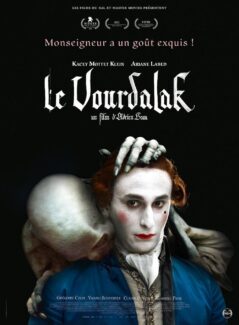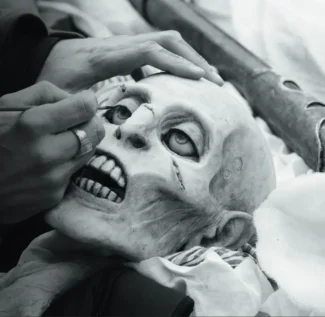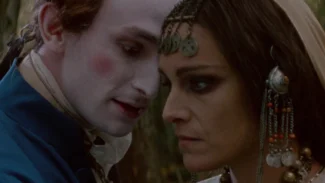The Vourdalak (Adrien Beau, 2023): France
Reviewed by Elyssa Crutchfield. Viewed at the Santa Barbara International Film Festival 2024
 The 91-minute folk-horror film The Vourdalak (2023) is the debut feature film of French writer/director Adrien Beau. Beau has previously directed two other horror short films, La Petite Sirene (2011) and Les Condiments Irreguliers (2011). In making The Vourdalak, Beau integrates his artistic abilities developed during these previous productions as well as his 10-year career in fashion design, working for fashion world icons such as John Galliano, Dior, and Agnes B. Shot on Super 16 and largely utilizing practical effects, Beau expertly immerses his audience in rural Eastern Europe. The Vourdalak is adapted from Russian author Aleksey Konstantinovich Tolstoy’s 1841 vampire novella, La Famille du Vourdalak, leaning into Eastern European folkloric vampires predating Bram Stoker’s Dracula and the rise of popular portrayals of vampires in horror.
The 91-minute folk-horror film The Vourdalak (2023) is the debut feature film of French writer/director Adrien Beau. Beau has previously directed two other horror short films, La Petite Sirene (2011) and Les Condiments Irreguliers (2011). In making The Vourdalak, Beau integrates his artistic abilities developed during these previous productions as well as his 10-year career in fashion design, working for fashion world icons such as John Galliano, Dior, and Agnes B. Shot on Super 16 and largely utilizing practical effects, Beau expertly immerses his audience in rural Eastern Europe. The Vourdalak is adapted from Russian author Aleksey Konstantinovich Tolstoy’s 1841 vampire novella, La Famille du Vourdalak, leaning into Eastern European folkloric vampires predating Bram Stoker’s Dracula and the rise of popular portrayals of vampires in horror.
When Marquis Jacques Antoine Saturnin d’Urfe (Kacey Mottet Klein), envoy of the King of France, gets ambushed and lost in the woods, he seeks shelter with a family anxiously awaiting the return of their patriarch, Gorcha. When Gorcha departed, he gave his family members an ultimatum: if he did not return in six days, to presume him dead, and if he returned after six days, to turn him away, for he would have become a vourdalak. It is never explained to Marquis d’Ufre or the audience what a vourdalak is, but when an emaciated Gorcha returns and starts preying on the blood of his family, a gruesome narrative unfolds in which the Marquis is caught in the middle of the cruel displays of love and amongst his hosts, isolated from the rest of the world.
 Unlike in most modern horror films, Beau solely utilizes practical effects, immersing his audience in an old-school-style horror film with his life-sized puppet of the decaying Gorcha and the dreamy atmosphere created by the Super 16 film it was shot on. Vampires in contemporary media are primarily based on the idea established by Bram Stoker: an immortal aristocrat, with all their wealth and power, able to satiate their bloodlust on the lower class without inhibitions. Conversely, vourdalaks, or folkloric vampires, which originate from Balkan and Slavic folktales, were typically peasant folk. They returned from the grave to feed on their family, ensuring the decimation of their bloodline and the death of all those they hold dear. Beau uses this history in order to convey how generational and cultural intolerances are passed down through generations. Pierre, the younger brother who is scorned for his more traditionally feminine affinities, tells the Marquis that “love itself is a curse in these parts,” addressing the patriarchal fealty that ultimately led to the decimation of their family.
Unlike in most modern horror films, Beau solely utilizes practical effects, immersing his audience in an old-school-style horror film with his life-sized puppet of the decaying Gorcha and the dreamy atmosphere created by the Super 16 film it was shot on. Vampires in contemporary media are primarily based on the idea established by Bram Stoker: an immortal aristocrat, with all their wealth and power, able to satiate their bloodlust on the lower class without inhibitions. Conversely, vourdalaks, or folkloric vampires, which originate from Balkan and Slavic folktales, were typically peasant folk. They returned from the grave to feed on their family, ensuring the decimation of their bloodline and the death of all those they hold dear. Beau uses this history in order to convey how generational and cultural intolerances are passed down through generations. Pierre, the younger brother who is scorned for his more traditionally feminine affinities, tells the Marquis that “love itself is a curse in these parts,” addressing the patriarchal fealty that ultimately led to the decimation of their family.
Overall, The Vourdalak expertly uses film as an artistic medium to invoke a repulsion towards Gorcha as a walking corpse but also as an overbearing and demanding paternal figure. The craftsmanship of the puppet, the eerie music and sound effects, notably the groaning and slurping noises that precede the appearance of Gorcha, and the costuming done by Anne Balanchard, identifying the roles of the various family members and their conformity or lack thereof, all envelop the audience in the horror of being destroyed by love. It is a film that is grotesquely horrifying but also emotionally compelling, and the relationships between the characters as they are pushed to their limits compels the audience to root for their triumph over what appears to be an inevitable and heartbreaking death. Unlike most modern horror films with their hand-sculpted faces, the fear of the monster is not to be overcome; the love of it is.
About this entry
You’re currently reading “The Vourdalak (Adrien Beau, 2023): France,” an entry on Student Film Reviews
- Published:
- 03.03.24 / 11pm
- Category:
- Films, Santa Barbara Film Festival 2024

No comments
Jump to comment form | comments rss [?]